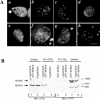Disease-related myotubularins function in endocytic traffic in Caenorhabditis elegans
- PMID: 14565969
- PMCID: PMC307539
- DOI: 10.1091/mbc.e03-08-0605
Disease-related myotubularins function in endocytic traffic in Caenorhabditis elegans
Abstract
MTM1, MTMR2, and SBF2 belong to a family of proteins called the myotubularins. X-linked myotubular myopathy, a severe congenital disorder characterized by hypotonia and generalized muscle weakness in newborn males, is caused by mutations in MTM1 (Laporte et al., 1996). Charcot-Marie-Tooth types 4B1 and 4B2 are severe demyelinating neuropathies caused by mutations in MTMR2 (Bolino et al., 2000) and SBF2/MTMR13 (Senderek et al., 2003), respectively. Although several myotubularins are known to regulate phosphoinositide-phosphate levels in cells, little is known about the actual cellular process that is defective in patients with these diseases. Mutations in worm MTM-6 and MTM-9, myotubularins belonging to two subgroups, disorganize phosphoinositide 3-phosphate localization and block endocytosis in the coelomocytes of Caenorhabditis elegans. We demonstrate that MTM-6 and MTM-9 function as part of a complex to regulate an endocytic pathway that involves the Arf6 GTPase, and we define protein domains required for MTM-6 activity.
Figures






References
-
- Berger, P., Bonneick, S., Willi, S., Wymann, M., and Suter, U. (2002). Loss of phosphatase activity in myotubularin-related protein 2 is associated with Charcot-Marie-Tooth disease type 4B1. Hum. Mol. Genet. 11, 1569–1579. - PubMed
-
- Blondeau, F., Laporte, J., Bodin, S., Superti-Furga, G., Payrastre, B., and Mandel, J.L. (2000). Myotubularin, a phosphatase deficient in myotubular myopathy, acts on phosphatidylinositol 3-kinase and phosphatidylinositol 3-phosphate pathway. Hum. Mol. Genet. 9, 2223–2229. - PubMed
-
- Bolino, A., et al. (2000). Charcot-Marie-Tooth type 4B is caused by mutations in the gene encoding myotubularin-related protein-2. Nat. Genet. 25, 17–19. - PubMed
Publication types
MeSH terms
Substances
LinkOut - more resources
Full Text Sources
Molecular Biology Databases

